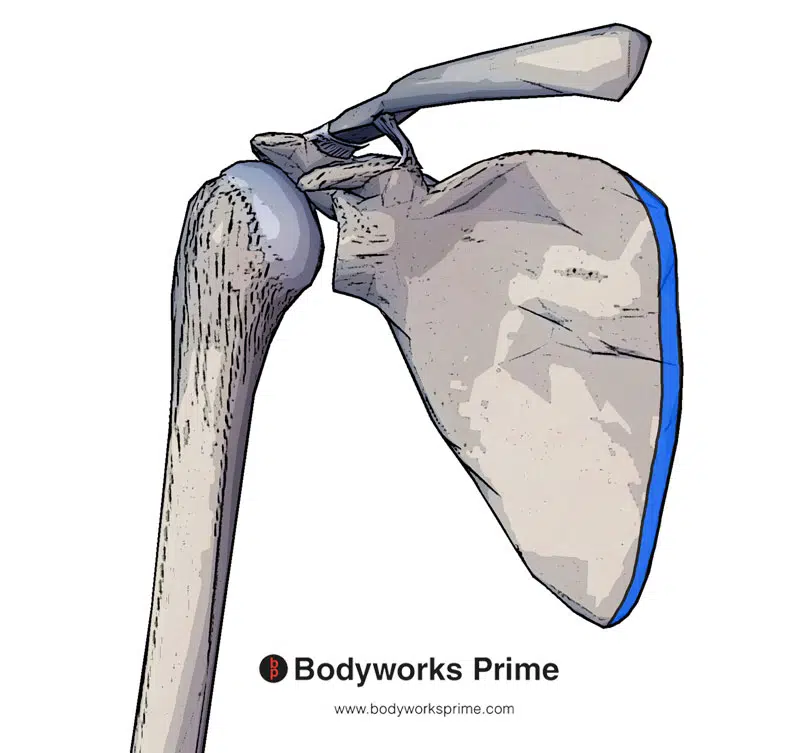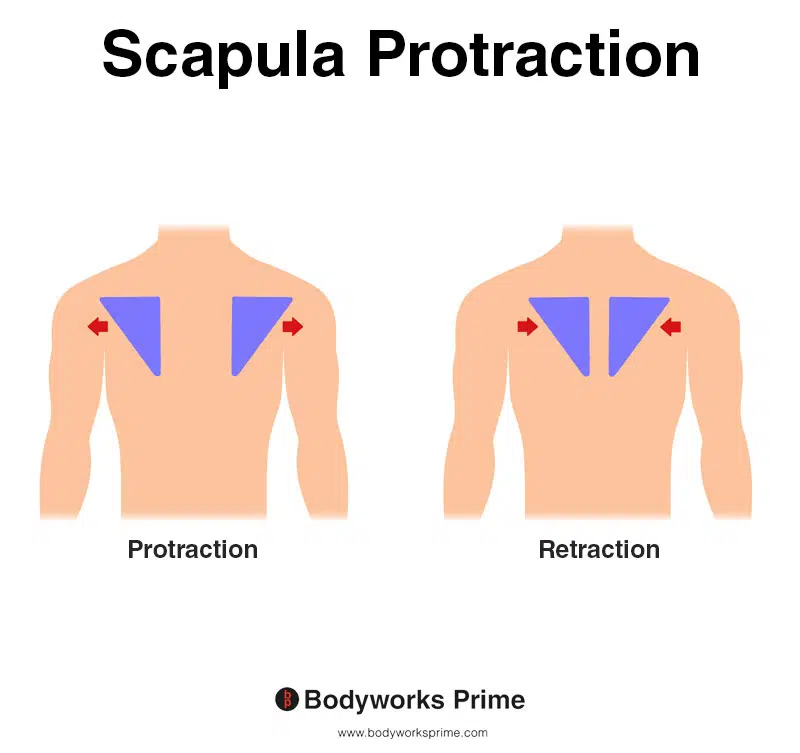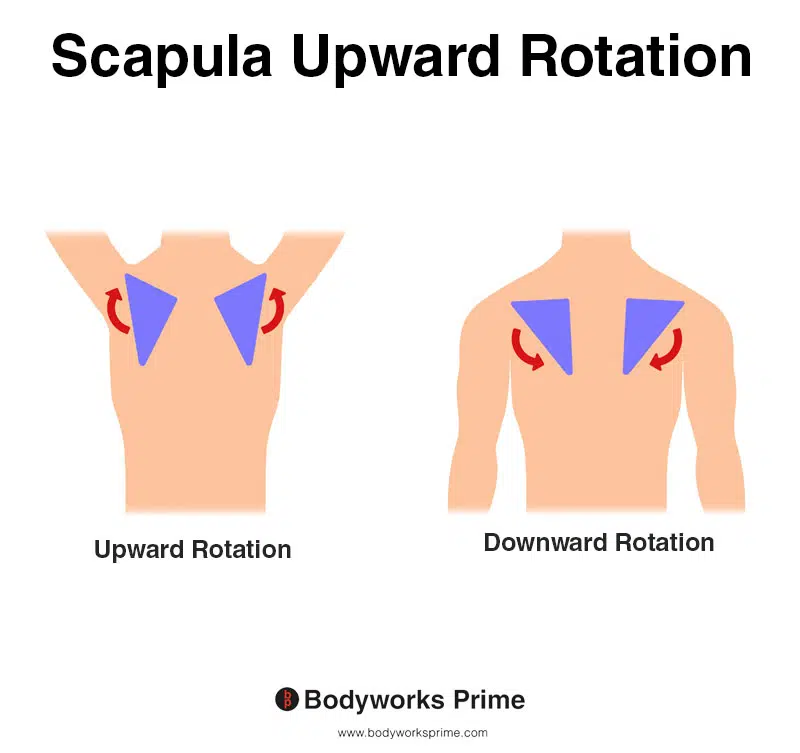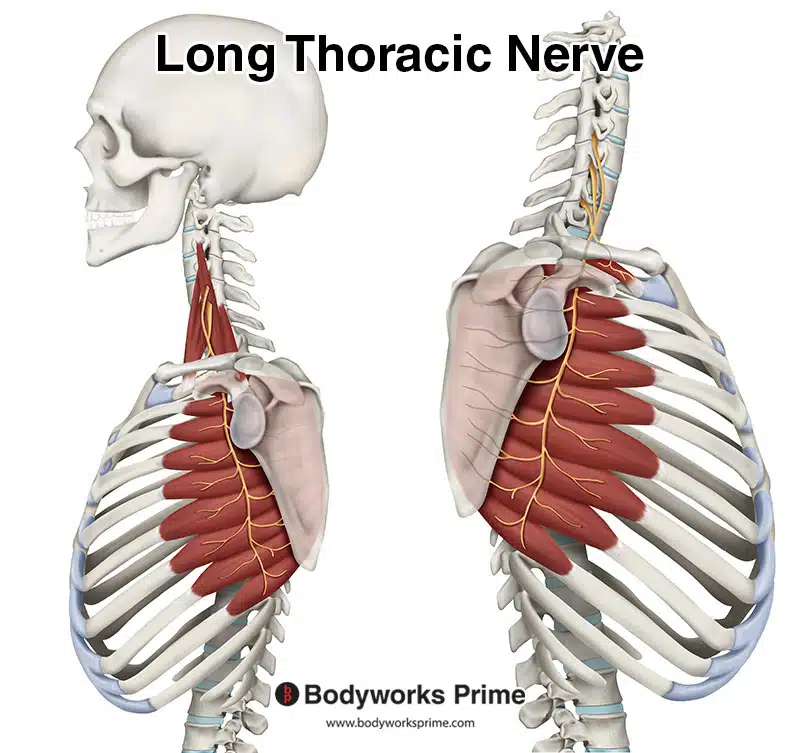| Origin | Superolateral surfaces of the first to eighth or ninth ribs |
| Insertion | Superior angle, medial border, and inferior angle of the scapula |
| Action | Protraction of the scapula Upward rotation of the scapula Can assist with respiration by lifting the ribs |
| Nerve | Long thoracic nerve (C5, C6, C7) |
| Artery | Lateral thoracic artery Superior thoracic artery Thoracodorsal artery |
Location & Overview
The serratus anterior is a fan-shaped muscle that is located on the thorax’s lateral wall. The serratus anterior muscle is located deep to the scapula, pectoralis major, and pectoralis minor. It is also deep to the subscapularis and it is separated from the subscapularis muscle by bursa or supraserratus bursa. It is possible to palpate the serratus anterior by pressing between the pectoralis major and latissimus dorsi muscles. In athletic individuals, with a low body fat percentage, it is often visible from the skin’s surface. It is usually divided into three different parts depending on the portion of its origin and insertion: serratus anterior inferior, serratus anterior intermediate, and serratus anterior superior. The specifics of the three sections are covered in further detail in the ‘origin and insertion’ section [1] [2] [3].
The serratus anterior is also commonly referred to as the ‘boxer’s muscle’ due to its role in the mechanics of boxing and other striking sports. When a boxer throws a punch, this muscle aids in the extension and forward movement of the arm (protraction of the scapula), allowing for a more forceful and effective strike. Additionally, the serratus anterior contributes to maintaining scapular stability, which is vital for both offensive and defensive techniques in boxing [4] [5].

Here we can see the serratus anterior muscle from an anterolateral view.

Here we can see the serratus anterior muscle from a lateral view.

Here we can see the serratus anterior muscle from a posterior view.

Here we can see the serratus anterior muscle seen from an anterior view.
Origin & Insertion
The serratus anterior is a muscle that wraps around the ribcage, originating from the first to either the eighth or ninth rib, before inserting onto the scapula. This muscle has three different parts, each connecting to different locations. The superior serratus anterior originates from the first and second ribs and inserts near the superior angle of the scapula. The intermediate serratus anterior originates from the third to sixth ribs and attaches along the medial border of the scapula. The inferior serratus anterior originates from the seventh to ninth ribs and inserts close to the scapula’s inferior angle. In some individuals, the serratus anterior may also originate from the tenth rib, or its origin may be absent from the first rib [6] [7] [8].

Here we can see the serratus anterior’s origins marked out in red. The serratus anterior originates on the superolateral surfaces of the first to eighth or ninth ribs.

Here we can see the serratus anterior’s insertion marked out in blue. The serratus anterior inserts on the superior angle, medial border, and inferior angle of the scapula.
Actions
The primary function of the serratus anterior muscle is to move the scapula anterolaterally around the thorax (towards the front of the body), which is known as scapular protraction. In addition, the serratus anterior aids in the upward rotation of the scapula, working alongside the trapezius muscle. Upward scapular rotation is important for raising the arms up, due to tilting the glenoid cavity upward and by doing so maintaining joint alignment. The glenoid cavity is where the head of the humerus sits. When the shoulders remain in a fixed position, the serratus anterior can contribute to respiration by elevating the ribs. Each segment of the serratus anterior plays a distinct role: the superior segment serves as the main axis of rotation, the middle segment pulls the scapula forward, and the inferior segment facilitates upward scapular rotation [9] [10]. The serratus anterior’s superior segment provides a main axis of rotation; the middle segment pulls the scapula forward; the inferior segment can rotate the scapula upward [11] [12] [13].

This image shows scapula protraction, a motion where the shoulder blade moves laterally and anteriorly along the rib cage (toward the front of the body). This movement occurs during actions such as reaching forward or pushing an object. The opposite of scapula protraction is scapula retraction. The serratus anterior’s primary action is scapula protraction.

This image shows scapula upward rotation, where the shoulder blade moves laterally and superiorly, tilting the glenoid cavity upward. This movement enables the arm to be raised overhead, while maintaining joint alignment. The opposite of scapula upward rotation is scapula downward rotation. Scapula upward rotation is another function of the serratus anterior.
The serratus anterior can also assist with respiration by lifting the ribs.
Innervation
Innervation of the serratus anterior is supplied by the long thoracic nerve (C5, C6, C7). The long thoracic nerve originates from the upper section of the superior trunk of the brachial plexus [14]. A way to remember the innervation is by remembering the mnemonic ‘SALT’ because the letters stand for ‘serratus anterior long thoracic’.

Pictured here we can see the long thoracic nerve which innervates the serratus anterior muscle with spinal roots from C5, C6, and C7.

Pictured here we can see the brachial plexus, which the long thoracic nerve is a part of.
Blood Supply
Blood is supplied to the serratus anterior via the lateral thoracic artery, superior thoracic artery, and the thoracodorsal artery [15].
Want some flashcards to help you remember this information? Then click the link below:
Serratus Anterior Flashcards
Support Bodyworks Prime
Running a website and YouTube channel can be expensive. Your donation helps support the creation of more content for my website and YouTube channel. All donation proceeds go towards covering expenses only. Every contribution, big or small, makes a difference!
References
| ↑1 | Nasu H, Yamaguchi K, Nimura A, Akita K. An anatomic study of structure and innervation of the serratus anterior muscle. Surg Radiol Anat. 2012 Dec;34(10):921-8. doi: 10.1007/s00276-012-0984-1. Epub 2012 May 26. PMID: 22638721. |
|---|---|
| ↑2, ↑6, ↑9, ↑12 | Lung K, St Lucia K, Lui F. Anatomy, Thorax, Serratus Anterior Muscles. [Updated 2021 Oct 7]. In: StatPearls [Internet]. Treasure Island (FL): StatPearls Publishing; 2022 Jan-. Available from: https://www.ncbi.nlm.nih.gov/books/NBK531457/ |
| ↑3, ↑4, ↑8 | Moore KL, Agur AMR, Dalley AF. Clinically Oriented Anatomy. 8th ed. Philadelphia: Lippincot Williams & Wilkins; 2017. |
| ↑5 | Lung K, Lui F. Anatomy, Thorax, Long Thoracic Nerve. [Updated 2022 Jul 25]. In: StatPearls [Internet]. Treasure Island (FL): StatPearls Publishing; 2023 Jan-. Available from: https://www.ncbi.nlm.nih.gov/books/NBK535396/ |
| ↑7, ↑10, ↑13 | Ekstrom RA, Bifulco KM, Lopau CJ, Andersen CF, Gough JR. Comparing the function of the upper and lower parts of the serratus anterior muscle using surface electromyography. J Orthop Sports Phys Ther. 2004 May;34(5):235-43. doi: 10.2519/jospt.2004.34.5.235. PMID: 15189015. |
| ↑11 | Gregg JR, Labosky D, Harty M, Lotke P, Ecker M, DiStefano V, Das M. Serratus anterior paralysis in the young athlete. J Bone Joint Surg Am. 1979 Sep;61(6A):825-32. PMID: 479228. |
| ↑14 | Laulan J, Lascar T, Saint-Cast Y, Chammas M, Le Nen D. Isolated paralysis of the serratus anterior muscle successfully treated by surgical release of the distal portion of the long thoracic nerve. Chir Main. 2011 Apr;30(2):90-6. doi: 10.1016/j.main.2011.02.003. Epub 2011 Mar 23. PMID: 21507700. |
| ↑15 | Gordon A, Alsayouri K. Anatomy, Shoulder and Upper Limb, Axilla. 2021 Jul 26. In: StatPearls [Internet]. Treasure Island (FL): StatPearls Publishing; 2022 Jan–. PMID: 31613503. |










